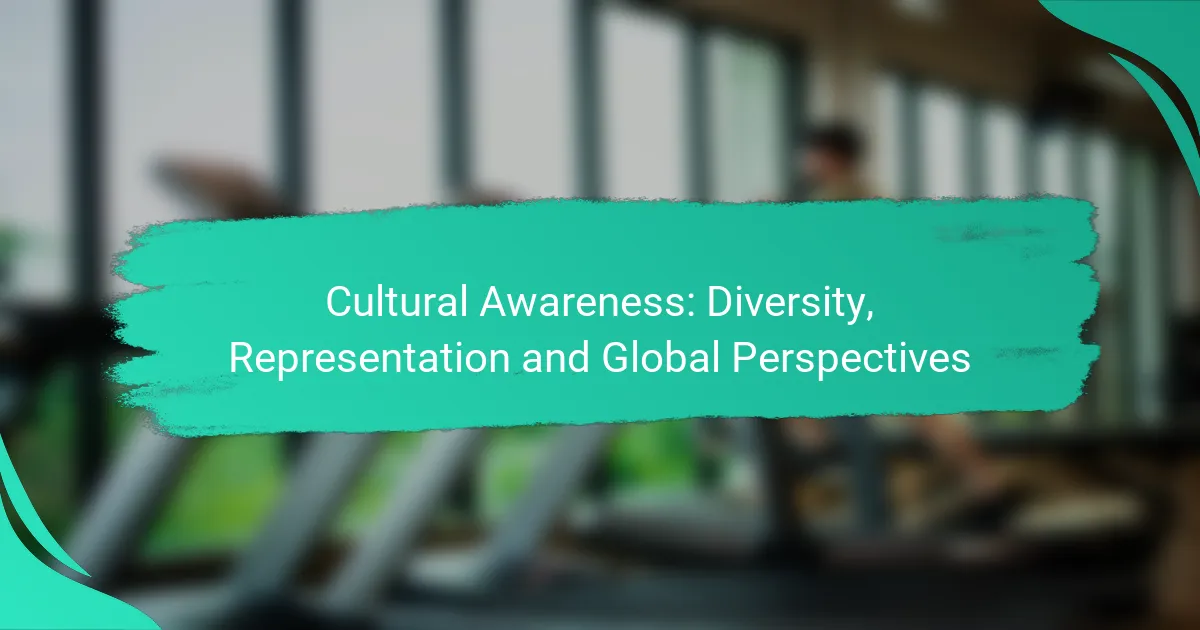Cultural awareness is essential in today’s globalized world, particularly in the design and development of digital products. By integrating diverse perspectives and inclusive practices, we can create experiences that resonate with a broad audience and reflect their unique backgrounds. Promoting diversity through training, partnerships, and community engagement not only enhances representation but also fosters a sense of belonging among users.

How to Foster Cultural Awareness in Digital Products?
Fostering cultural awareness in digital products involves integrating diverse perspectives and inclusive practices throughout the design and development process. This ensures that products resonate with a wide range of users and reflect their varied backgrounds and experiences.
Inclusive design principles
Inclusive design principles focus on creating products that are accessible and usable by people from diverse backgrounds. This includes considering factors such as language, visual representation, and user interface navigation to accommodate different cultural contexts.
For instance, using color schemes that are culturally significant or providing multilingual support can enhance user experience. Aim to involve individuals from various demographics in the design process to ensure a broader perspective.
User feedback integration
Integrating user feedback is crucial for understanding how different cultural groups interact with your digital product. Regularly collect feedback through surveys, focus groups, or usability testing to identify cultural nuances that may affect user experience.
Consider implementing feedback loops where users can easily report issues or suggest improvements. This not only helps in refining the product but also fosters a sense of community and belonging among users.
Diverse content representation
Diverse content representation ensures that the material presented in digital products reflects the variety of cultures and experiences of users. This can include images, stories, and examples that resonate with different cultural backgrounds.
When curating content, strive for authenticity and avoid stereotypes. Collaborating with cultural consultants or representatives can help ensure that the content is respectful and accurately represents the communities involved.

What Are Effective Strategies for Promoting Diversity?
Effective strategies for promoting diversity include implementing comprehensive training programs, forming partnerships with diverse creators, and engaging with local communities. These approaches foster an inclusive environment that values different perspectives and backgrounds.
Training programs for teams
Training programs are essential for educating teams about diversity and inclusion. These programs should cover topics such as unconscious bias, cultural competence, and inclusive communication practices. Regular workshops can reinforce these concepts and encourage ongoing dialogue.
Consider using a mix of formats, such as online courses and in-person sessions, to cater to different learning styles. Aim for a frequency of at least once or twice a year to keep the conversation active and relevant.
Partnerships with diverse creators
Forming partnerships with diverse creators can enhance representation and bring fresh perspectives to projects. Collaborating with individuals from various backgrounds not only enriches content but also helps reach wider audiences. Seek out creators who align with your values and mission.
When establishing these partnerships, ensure that compensation is fair and reflective of the creators’ contributions. This approach fosters mutual respect and encourages long-term collaboration.
Community engagement initiatives
Community engagement initiatives are vital for building relationships and understanding local needs. These initiatives can include sponsoring local events, supporting minority-owned businesses, or hosting cultural exchange programs. Engaging directly with the community fosters trust and demonstrates commitment to diversity.
To maximize impact, involve community members in the planning process. This ensures that initiatives are relevant and beneficial, creating a sense of ownership and pride among participants.

How Does Representation Impact User Experience?
Representation significantly influences user experience by ensuring that diverse perspectives are included in design and content. When users see themselves reflected in products and services, it fosters a sense of belonging and enhances overall satisfaction.
Improved user satisfaction
When users encounter content and interfaces that resonate with their cultural backgrounds, they are more likely to feel understood and valued. This connection can lead to higher satisfaction rates, as users appreciate products that cater to their specific needs and preferences.
For example, a website that offers multilingual options or culturally relevant imagery can create a more welcoming environment for diverse users. This approach not only enhances usability but also promotes a positive emotional response.
Increased brand loyalty
Brands that prioritize representation often cultivate stronger loyalty among their users. When customers feel that their identities are acknowledged and celebrated, they are more inclined to remain loyal to that brand over time.
Consider companies that actively engage with diverse communities through targeted marketing campaigns or partnerships. Such initiatives demonstrate a commitment to inclusivity, which can translate into repeat business and positive word-of-mouth referrals.
Broader market reach
Emphasizing representation allows brands to tap into previously underserved markets, expanding their reach and potential customer base. By understanding and addressing the unique needs of diverse groups, companies can create products that appeal to a wider audience.
For instance, a fashion retailer that offers a range of sizes and styles for different cultural preferences can attract customers from various backgrounds. This strategy not only increases sales but also enhances the brand’s reputation as an inclusive leader in the industry.

What Are the Key Components of Global Perspectives?
Global perspectives encompass understanding and appreciating diverse cultures, viewpoints, and practices across the world. Key components include cultural sensitivity training, understanding local customs, and adapting marketing strategies to resonate with different audiences.
Cultural sensitivity training
Cultural sensitivity training equips individuals and organizations with the skills to interact respectfully and effectively with people from diverse backgrounds. This training often covers topics such as unconscious bias, communication styles, and cultural norms.
Organizations should consider implementing regular training sessions, especially for employees who engage with international clients or partners. Effective training can lead to improved teamwork, reduced conflict, and enhanced customer relations.
Understanding local customs
Understanding local customs is crucial for fostering positive interactions in different cultural contexts. This includes recognizing social norms, traditions, and etiquette that may vary significantly from one culture to another.
For instance, in some cultures, direct eye contact is a sign of confidence, while in others, it may be perceived as disrespectful. Taking the time to research and respect these differences can help avoid misunderstandings and build trust.
Adapting marketing strategies
Adapting marketing strategies to fit local cultures is essential for effective outreach. This involves tailoring messages, visuals, and even product offerings to align with local preferences and values.
For example, a campaign that works well in the United States may not resonate in Japan due to differing cultural attitudes. Marketers should conduct thorough market research and consider local languages, symbols, and consumer behavior when developing campaigns.

What Tools Can Enhance Cultural Awareness?
Enhancing cultural awareness involves utilizing various tools that facilitate understanding and appreciation of diverse perspectives. These tools can help individuals and organizations assess their cultural intelligence, collaborate effectively, and measure diversity metrics.
Cultural intelligence assessments
Cultural intelligence assessments are tools designed to evaluate an individual’s ability to relate and work effectively across cultures. These assessments typically measure cognitive, emotional, and behavioral aspects of cultural intelligence, providing insights into strengths and areas for improvement.
Organizations can use these assessments to tailor training programs that enhance employees’ cultural competencies. For example, a company might implement a cultural intelligence assessment as part of its onboarding process to prepare new hires for a diverse workplace.
Collaboration platforms
Collaboration platforms facilitate communication and teamwork among individuals from different cultural backgrounds. These digital tools often include features like video conferencing, file sharing, and discussion forums, enabling seamless interaction regardless of geographical location.
When selecting a collaboration platform, consider user-friendliness and accessibility to ensure all team members can engage effectively. Popular platforms like Slack or Microsoft Teams can help bridge cultural gaps by allowing diverse teams to share ideas and feedback in real-time.
Analytics for diversity metrics
Analytics for diversity metrics involve collecting and analyzing data related to workforce diversity. This can include demographic information, hiring trends, and retention rates, which help organizations understand their diversity landscape and identify areas needing attention.
Using analytics tools, companies can set measurable diversity goals and track progress over time. For instance, a business might aim to increase representation of underrepresented groups by a certain percentage within a specified timeframe, using data to inform their strategies and initiatives.

How to Measure the Effectiveness of Cultural Initiatives?
Measuring the effectiveness of cultural initiatives involves assessing their impact on diversity, representation, and global perspectives. Key methods include gathering feedback, analyzing performance metrics, and reviewing successful case studies to understand what works best in fostering an inclusive environment.
Surveys and feedback loops
Surveys are a direct way to gauge employee and community perceptions of cultural initiatives. They can include questions about inclusivity, representation, and overall satisfaction with cultural programs. Regular feedback loops, such as follow-up surveys or focus groups, help organizations adapt and improve their initiatives based on participant input.
To enhance the effectiveness of surveys, consider using a mix of quantitative and qualitative questions. For example, a Likert scale can quantify satisfaction levels, while open-ended questions can provide deeper insights into specific experiences.
Performance metrics analysis
Analyzing performance metrics is crucial for evaluating the success of cultural initiatives. Metrics may include participation rates, retention rates of diverse employees, and the impact on team dynamics. Tracking these metrics over time allows organizations to identify trends and areas needing improvement.
For a comprehensive analysis, compare metrics before and after implementing cultural initiatives. This can reveal the direct impact of these programs and help justify continued investment in diversity and inclusion efforts.
Case studies of successful implementations
Reviewing case studies of successful cultural initiatives can provide valuable insights and best practices. Organizations that have effectively enhanced diversity often share their strategies, challenges, and outcomes, serving as models for others. These examples can highlight innovative approaches and practical solutions that have led to measurable improvements.
When studying case studies, focus on the context, goals, and specific actions taken. Look for key takeaways that can be adapted to your organization’s unique culture and objectives, ensuring relevance and applicability to your situation.
